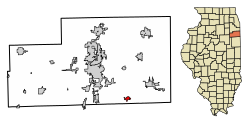St. Anne, Illinois
St. Anne | |
|---|---|
 Shrine and parish church of St. Annes | |
 Location of St. Anne in Kankakee County, Illinois. | |
 Location of Illinois in the United States | |
| Coordinates: 41°1′24″N 87°43′1″W / 41.02333°N 87.71694°W | |
| Country | United States |
| State | Illinois |
| County | Kankakee |
| Area | |
• Total | 0.81 sq mi (2.09 km2) |
| • Land | 0.78 sq mi (2.03 km2) |
| • Water | 0.02 sq mi (0.06 km2) |
| Elevation | 664 ft (202 m) |
| Population (2010) | |
• Total | 1,257 |
• Estimate (2016)[2] | 1,209 |
| • Density | 1,544.06/sq mi (595.98/km2) |
| Time zone | UTC-6 (CST) |
| • Summer (DST) | UTC-5 (CDT) |
| ZIP Code(s) | 60964 |
| Area code(s) | 815 & 779 |
| FIPS code | 17-66638 |
| Wikimedia Commons | St. Anne, Illinois |
| Website | www |
St. Anne is a village in Kankakee County, Illinois, United States. The population was 1,212 at the 2000 census, and 1,247 in 2009. It is part of the Kankakee–Bourbonnais–Bradley Metropolitan Statistical Area. It was founded by Charles Chiniquy, a French Canadian Roman Catholic priest (who later converted to Protestantism) and friend of Abraham Lincoln.
Geography
St. Anne is located at 41°1′24″N 87°43′1″W / 41.02333°N 87.71694°W (41.023363, -87.717050).[3]
According to the 2010 census, St. Anne has a total area of 0.793 square miles (2.05 km2), of which 0.77 square miles (1.99 km2) (or 97.1%) is land and 0.023 square miles (0.06 km2) (or 2.9%) is water.[4]
Demographics
| Census | Pop. | Note | %± |
|---|---|---|---|
| 1880 | 412 | — | |
| 1890 | 718 | 74.3% | |
| 1900 | 1,000 | 39.3% | |
| 1910 | 1,065 | 6.5% | |
| 1920 | 1,067 | 0.2% | |
| 1930 | 1,078 | 1.0% | |
| 1940 | 1,131 | 4.9% | |
| 1950 | 1,403 | 24.0% | |
| 1960 | 1,378 | −1.8% | |
| 1970 | 1,271 | −7.8% | |
| 1980 | 1,421 | 11.8% | |
| 1990 | 1,153 | −18.9% | |
| 2000 | 1,212 | 5.1% | |
| 2010 | 1,257 | 3.7% | |
| 2016 (est.) | 1,209 | [2] | −3.8% |
| U.S. Decennial Census[5] | |||
As of the census[6] of 2000, there were 1,212 people, 464 households, and 330 families residing in the village. The population density was 2,385.3 people per square mile (917.6/km²). There were 486 housing units at an average density of 956.5 per square mile (367.9/km²). The racial makeup of the village was 89.85% White, 0.83% African American, 0.41% Native American, 0.08% Asian, 0.08% Pacific Islander, 6.60% from other races, and 2.15% from two or more races. Hispanic or Latino of any race were 10.48% of the population.
There were 464 households out of which 36.9% had children under the age of 18 living with them, 55.0% were married couples living together, 11.2% had a female householder with no husband present, and 28.7% were non-families. 23.3% of all households were made up of individuals and 11.2% had someone living alone who was 65 years of age or older. The average household size was 2.61 and the average family size was 3.08.
In the village, the population was spread out with 30.0% under the age of 18, 8.3% from 18 to 24, 28.1% from 25 to 44, 20.2% from 45 to 64, and 13.5% who were 65 years of age or older. The median age was 34 years. For every 100 females, there were 96.4 males. For every 100 females age 18 and over, there were 89.5 males.
The median income for a household in the village was $39,306, and the median income for a family was $41,250. Males had a median income of $32,000 versus $25,086 for females. The per capita income for the village was $16,702. About 11.7% of families and 13.4% of the population were below the poverty line, including 18.2% of those under age 18 and 6.4% of those age 65 or over.
Notable person
- Jack Sikma, seven-time NBA All-Star and center for 1979 NBA champion Seattle SuperSonics, attended St. Anne High School.
See also
- Revolution, television series which dramatized St. Anne, Illinois
References
- ^ "2016 U.S. Gazetteer Files". United States Census Bureau. Retrieved Jun 30, 2017.
- ^ a b "Population and Housing Unit Estimates". Retrieved June 9, 2017.
- ^ "US Gazetteer files: 2010, 2000, and 1990". United States Census Bureau. 2011-02-12. Retrieved 2011-04-23.
- ^ "G001 - Geographic Identifiers - 2010 Census Summary File 1". United States Census Bureau. Retrieved 2015-12-25.
- ^ "Census of Population and Housing". Census.gov. Retrieved June 4, 2015.
- ^ "American FactFinder". United States Census Bureau. Retrieved 2008-01-31.

